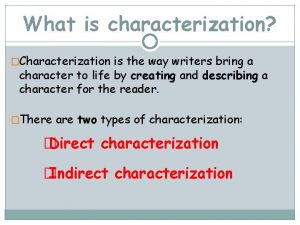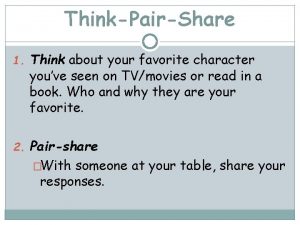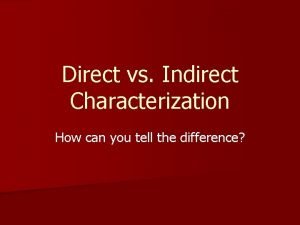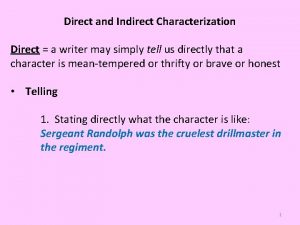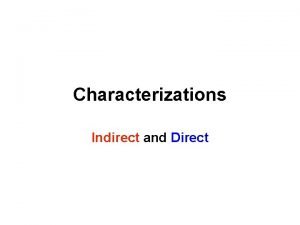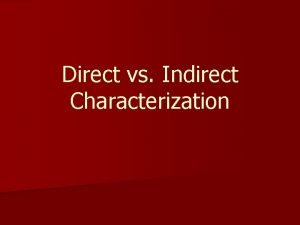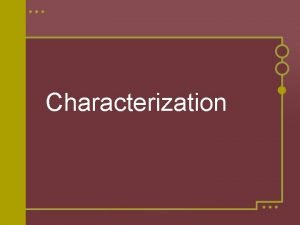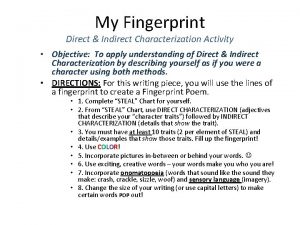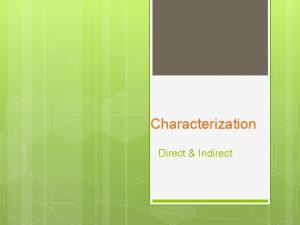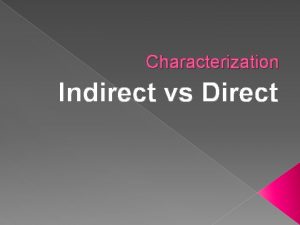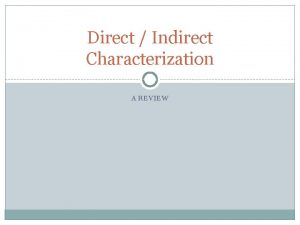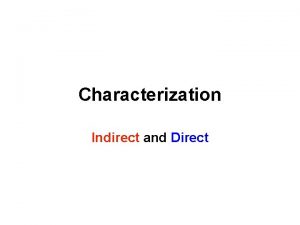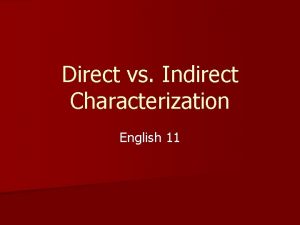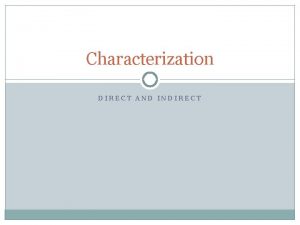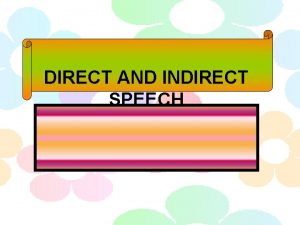Characterization Direct and Indirect Characterization is the process















- Slides: 15

Characterization Direct and Indirect

Characterization is the process by which the author reveals the personality of the character. Two types of characterization: Direct Characterization Indirect Characterization

Direct Characterization Direct characterization tells the audience what the personality of the character is.

Direct Characterization “The patient boy and quiet girl were well mannered and never disobeyed their mother. ” Mickey Mouse is a handsome mouse who is very funny. The author directly tells the personality The boy is “patient” The girl is “quiet” Mickey is both “handsome” and “funny”.

Indirect Characterization shows things that reveal the personality of the character.

Indirect Characterization There are five methods of indirect characterization (Steal): Speech Thoughts Emotions/Effect on others Actions Looks

Indirect Characterization Speech. What does the character say? How does the character speak? Sarah said, “The world has a lot to offer someone; they just have to go out there and get it. ”

Indirect: Speech What someone says is important. Think: Do they say different things to different characters? Do they tell the truth? How do they speak to others?

Indirect Characterization Thoughts. What is revealed through the character’s private thoughts or feelings? He was thinking it was a bad idea, but there was no way he could tell his best friend no.

Indirect Characterization Effect on others toward the character, and their own emotions. What is revealed through the character’s effect on other people? How do other characters think and behave in reaction to the character? Rachel had hurt Amanda’s feelings. How could Rachel start dating the guy Amanda had been flirting with for the past two months? Amanda began cry in heaping sobs.

Indirect Characterization Actions. What does the character do? How does the character behave? �He began to run. He didn’t know where he was going, nor did he care. He shouted profanity at the cops as he took off down the alleyway.

Indirect Characterization Looks. What does the character look like? How does the character dress? He was tall for his age. His hair wast he color of a fresh squeezed orange, and he wore a tailored suit to match the scowl on his face.

How to Characterize Look for Direct Characterization first. This is whenever the author or another character tells you something about that character; even if it is in quotes. Be sure to gather anything you can that the author readily provides you- they want you to understand empathize with their characters!

How to Characterize Indirect Characterization is more difficult; look for clues where you have to infer information. Whenever you read something and it makes you question the character, that is indirect characterization. Use the STEAL method to help you. Start with one letter, and review the pages you’ve read to see how the author implies information about the character.

 Whats direct characterization
Whats direct characterization What does indirect characterization mean
What does indirect characterization mean What is characterizatin
What is characterizatin Indirect and direct characterization
Indirect and direct characterization Indirect characterization
Indirect characterization Direct characterization.
Direct characterization. What is indirect characterization
What is indirect characterization About my character
About my character What is indirect characterization
What is indirect characterization Teaching direct and indirect characterization
Teaching direct and indirect characterization Characterization direct and indirect
Characterization direct and indirect Indirect characterization definition
Indirect characterization definition What is direct characterization
What is direct characterization Whats direct and indirect characterization
Whats direct and indirect characterization Direct and indirect characterization activities
Direct and indirect characterization activities Betty parris the crucible indirect characterization
Betty parris the crucible indirect characterization


